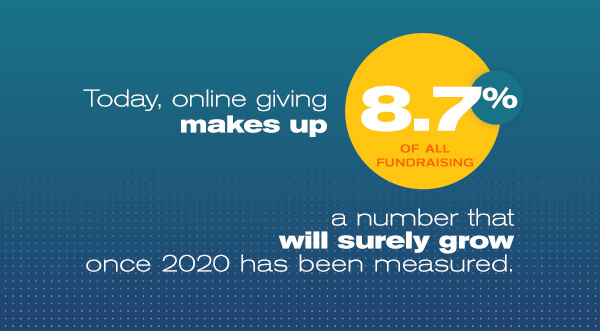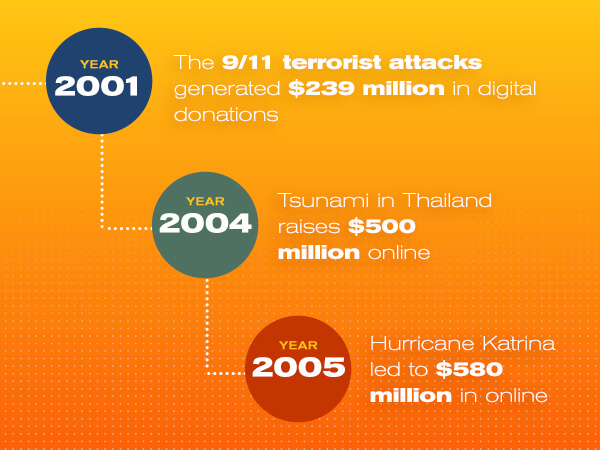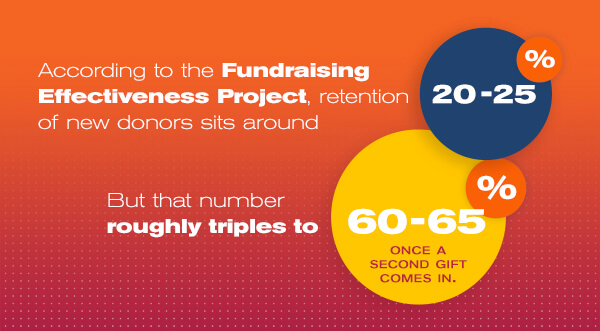Everything is going digital these days, and fundraising is certainly no exception.
The nonprofit industry has seen tremendous growth in digital fundraising in the last decade.

In fact, the biggest differentiator we consistently see in individual fundraising programs is digital giving. Those nonprofits that have a sophisticated multichannel strategy are growing. Those that don’t are stagnant or declining.
If your nonprofit organization hasn’t jumped online yet (or maybe just dipped a toe in the water), the time to invest is now. But where do you begin?
In today’s world of Facebook, Amazon and Google, people have high expectations for how they will be treated in digital communications. That’s why nonprofits must use personalization, automation and segmentation to deliver the right message to the right donor at the right time.
In this article, we’ll review everything you need to know to build a successful online fundraising program, including:
- What drives digital donors to give
- When and where donors give digitally
- How to retain and cultivate these online donors
- Key events, dates and seasons for online giving
HISTORY OF ONLINE FUNDRAISING
Let’s start with a brief history lesson.
Before Facebook, iPhone or YouTube entered our social consciousness, companies were thinking of ways to give online.
In 1999, Convio (now Blackbaud Luminate) and Helping.org (now Network for Good) became the pioneers of digital donations – at a time when only 52% of American adults were on the internet. These two platforms were the first to provide software to nonprofits that allowed people to give online through the website.
Thus, the “donate” button was born.
From there, things moved quickly. Times of crisis and disaster led to tremendous waves of charity as people discovered a fast and easy way to make a difference:

Charities began to take notice, and they looked for ways to harness the power of this new form of donating.
A perfect example is the rapid growth of Giving Tuesday, which launched in 2012 with $10.1 million in digital donations. In just seven years, Giving Tuesday has grown into a global phenomenon, with $511 million donated in 2019.
Today, internet access has reached 90% across the United States, and successful nonprofits use a complex multichannel strategy to reach donors by email, social media, digital ads, text messages and more.
WHAT MAKES ONLINE GIVING WORK SO WELL?
We touched on this a bit above, but let’s look at this a little more closely. There are three important reasons why online giving works:
1. It’s timely
You can plan and schedule exactly when an email hits an inbox or when a post goes up on Facebook. This meticulous timing allows nonprofits to tailor time-sensitive messages for donors that won’t be outdated when they arrive:
- Giving Tuesday is Tomorrow! Help Now
- Hunger Action Month is Here!!!
- Hurricane Laura Has Made Landfall
2. It’s urgent
Simply put: Digital moves fast. When a disaster or other event happens, an email or a social media post can be crafted rapidly to get the word out to donors and ask for immediate help.
Compare that to the production time of a DRTV spot or the planned-out schedule of direct mail. Those channels are terrific for generating a deep connection – essential to building a relationship with donors – but they take time to execute.
When an urgent message is needed, digital channels are essential.
3. It’s deadline oriented
Combining the ideas of timely and urgent, you can drive donors toward a goal with a clear end in sight. Deadlines force action by creating an impulse to act, and digital channels can be specific:
- Last Chance: Triple Your Impact Before Midnight
- Bidding ends tonight
- Time’s Almost Up: TRIPLE Your Gift Today
Direct-response marketing and digital fundraising fit together perfectly. A method designed to generate an immediate response merges with channels that can deliver a donation in a few clicks.
Now that we know why online fundraising works, let’s examine how to bring in new donors, keep them around and eventually motivate them to provide larger gifts.
ACQUIRING NEW DIGITAL DONORS
In direct mail, acquisition is primarily about list optimization and modeling. Nonprofits must build a strong mailing list with the right balance of high-wealth individuals who have shown a pattern of philanthropic giving.
In digital fundraising, acquisition looks a little different.
There are a host of tools and channels nonprofits can use to bring in new online donors, and it takes the right strategy to balance the proper tactics.
Here is a quick look at some of the ways you can acquire contact information online:
- Email signup: Create a form to acquire email addresses to build a digital database.
- Lightbox: Use this pop-up on your website to ask for email addresses or donations.
- Donate button: Direct people to your donation form with a clear button that stands out visually.
- Social fans/followers: Get people to like or follow your social media pages.
- Text signup: Just like with email, ask people to provide their mobile phone numbers.
And here are a few channels you can use to get your message out to new donors:
- Organic search: A strong SEO strategy can bring people to your website while they’re looking for more information on a topic.
- Paid search: Complement your organic strategy with paid search efforts that target specific behaviors.
- Paid social/display: Create lookalike audiences to reach donors who are similar to your current ones.
- Earned media: Build relationships with news and industry publications to spread the word when you need help.
Two tactics we definitely do not recommend are email list rentals and email appends. Both can be expensive, and neither option performs well.
Stick to those who have provided their information willingly, and you’ll be in good shape.
BUILDING A RELATIONSHIP
Of course, the ultimate goal of any fundraising program is to bring in donations. Some donors begin their journey with a gift, while others slowly work their way up to it.
In either case, the key to retaining these donors is to start building a relationship with them.
Email is a great digital tool for donor engagement after someone has given a donation (don’t forget to say “thanks”) or signed up to receive communication. Nonprofits can segment their email lists, use that data for personalization and then automate a series of emails to reach donors.
We recommend beginning with a welcome series that invites new constituents to form a deeper relationship with the organization. You can set a series of emails to arrive in their inbox a day after they donate, then a week after, a month later, etc.
Nonprofits can time these emails based on the initial action and then share information about the impact of the gift, eNewsletters, events that may be happening, videos to learn more, etc.
This is also a chance to have some fun with engaging emails that have amusing animations, recipes and more. The idea is putting something in people’s inbox that isn’t just an ask for gifts.
The website itself is another tool for keeping people engaged and informed as you build that relationship. Make sure your site is easy to navigate and provides the most important info that users want to see in the most important locations on the site.
Finally, social media is a great channel for engagement. Much like in email, you can share posts on a wide variety of topics. With email, you don’t want to flood someone’s inbox. But social posts can go up multiple times a day because not all followers will see every post – even if they’re on that social channel.
BRINGING IN A SECOND GIFT
A strong indication that you’re building a relationship with donors is getting a second gift. Similar to acquisition, nonprofits can engage a variety of channels to bring in a second gift:
- Email: eAppeals should be mixed in with information, videos and reports of impact. There are plenty of effective eAppeal tactics and strategies.
- Website: Feature a clear donate button that stands out from the navigation at the top right of the home page. Lightboxes, widgets and rotating carousels can also promote giving.
- Paid media: Remarket to those who have visited the website or have opted out of email communication through ads on social media, display and search.
- SMS: Text messages can be sent to donors to ask for a donation.
- Organic social: Much like with email, nonprofits should regularly mix appeals into their posts on Facebook, Twitter, Instagram, etc.

KEY EVENTS, DATES AND SEASONS
Online giving happens all year long, but there are some key events, dates and seasons to note:
- Match campaign: A single-day campaign where donations are matched by a large gift. The donations can also be doubled, tripled or even quadrupled to encourage more giving.
- Month-long campaign: Can be promoted in a variety of channels over time and coordinated across channels (including offline).
- Giving day: Similar to a single-day match, but it can be promoted through the press and is an annual event. Giving days can be unique to a nonprofit or part of a regional effort.
- #GivingTuesday: The first Tuesday after Thanksgiving is a global fundraising event that can bring in up to 10% of a nonprofit’s annual online giving.
- December: Up to 50% of digital revenue comes in the final month each year, with most giving happening Dec. 27-31.





Leave a comment: